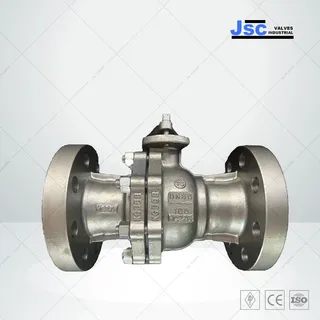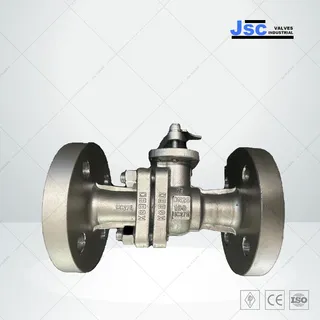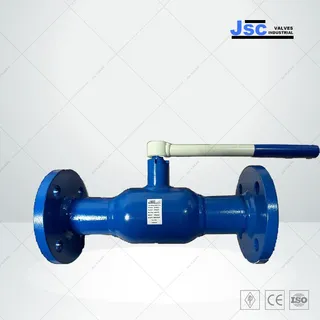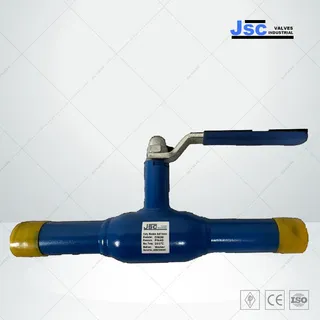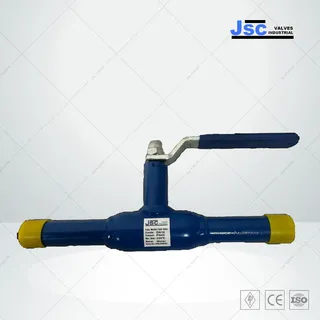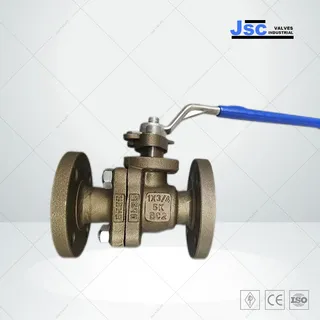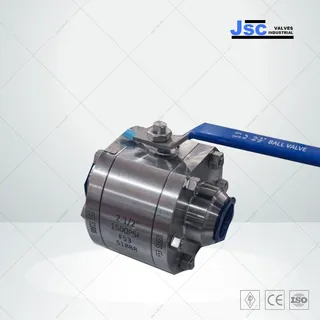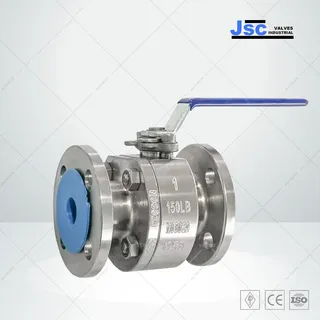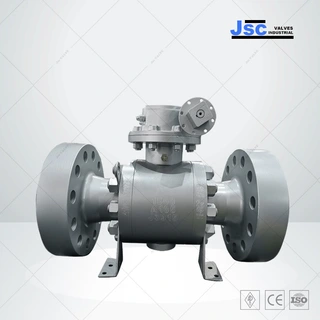Ball Valves
A Ball Valve is a quarter-turn rotational valve featuring a hollow, perforated, and pivoting ball mechanism designed to regulate the flow of fluids. Recognized for its widespread application and versatility, this valve is esteemed for its simplicity, durability, and dependable performance. The valve gets its name from the spherical-shaped ball inside the body, which has a hole (bore) drilled through its center. When the hole lines up with the water, the valve is open, letting the water through. Turn the ball 90 degrees, and the hole blocks the water, closing the valve.
1-12 of 95 results
JSC-20241009-FBV-05
This Two Piece Floating Ball Valve is constructed from Hastelloy C276 and designed for 3-inch applications with a pressure rating of Class 600 LB. It features a full bore design, a soft seat for optimal sealing, and a bolted bonnet for easy maintenance. Lever operated, it comes with RF flanged ends, making it suitable for various demanding industrial applications.
JSC-20241009-FBV-04
This Hastelloy C276 Floating Ball Valve is designed for 1-inch size (DN25) applications with a pressure rating of Class 600 LB (PN100). It features a 2-piece construction with a soft seat, bolted bonnet, and anti-static design for enhanced safety. The valve is fire-safe and comes with RF flanged connections, making it suitable for demanding industrial environments.
JSC-20241009-FWBV-01
This ST 37.8 Floating Ball Valve, manufactured per DIN EN 10217-2 standards, features a 2-inch size (DN50) with a pressure rating of PN40 (Class 300 LB). The valve is fully welded with a reduced bore design and comes with butt-welded (BW) ends for secure installation. It is lever operated, ensuring reliable performance in various industrial applications.
JSC-20241009-FBV-03
This Fully Welded Floating Ball Valve, compliant with DIN EN 10217-2 standards, features a ST 37.8 construction with a reduced ball design. Designed for 3/4 inch (DN20) applications, it has a pressure rating of PN40 (Class 300 LB) and is suitable for district heating systems. The valve comes with flanged ends for easy installation and secure connections.
JSC-20241009-FBV-02
This Fully Welded Floating Ball Valve, manufactured to DIN EN 10217-2 standards, features a ST 37.8 body and a stainless steel 304 ball. Designed for DN20 (3/4 inch) applications with a pressure rating of PN40 (Class 300 LB), it is ideal for district heating systems. The valve comes with butt-welded (BW) ends, ensuring robust and leak-free connections for reliable performance.
JSC-20241009-FBV-01
This District Heating Floating Ball Valve, compliant with DIN EN 10217-2 standards, features ST 37.8 construction and is designed for DN15 (1/2 inch) applications with a pressure rating of PN40 (Class 300 LB). The valve is fully welded, has a reduced bore for improved flow characteristics, and is lever operated, ensuring reliable performance in district heating systems.
JSC-240621-FBV-02
This Cast Bronze Floating Ball Valve adheres to JIS H5111 BC2 standards and is constructed from durable cast bronze. It features a compact size of 1 inch x 3/4 inch with a pressure rating of 5K (PN5), suitable for low-pressure applications. The valve is equipped with a soft seat for reliable sealing, a bolted bonnet for secure closure, and a two-piece body design for ease of maintenance. Its RF ends ensure leak-free connections and straightforward installation in piping systems. Ideal for various industrial and marine applications, this valve combines robust construction with efficient performance.
JSC-240621-FBV-01
The ASTM A182 F53 Floating Ball Valve, supplied with a forged duplex stainless steel body, features a robust two-piece design compliant with API 6D standards. Sized at 2-1/2 inches with a pressure rating of 1500 PSI, it is engineered for reliability in high-pressure environments. Equipped with an RPTFE seat for superior sealing and butt weld (BW) ends for secure pipeline integration, this valve ensures efficient performance and minimal leakage, making it ideal for demanding industrial applications requiring durability and resilience.
JSC-240524-FBV-02
Introducing our UNS N08020 Floating Ball Valve: Crafted from forged Nickel Alloy 20 for durability and corrosion resistance. Compliant with API 6D standards, it ensures quality and reliability. Sized at 1 inch (DN25) for Class 150 LB and PN20 applications, it's ideal for diverse industries. With anti-static and fire-safe design features, it enhances safety in critical environments. Equipped with SW ends for secure sealing, our valve offers dependable performance in fluid control applications.
JSC-240524-FBV-01
Introducing our Nickel Alloy 20 Floating Ball Valve: Precision-engineered for reliability and performance in demanding environments. Crafted from UNS N08020 material, it meets API 6D standards, ensuring quality. Sized at 1 inch for Class 150 LB applications, it's ideal for various industries. Featuring a two-piece body, soft seat, and full bore design, it ensures efficient fluid control. With a bolted bonnet and RF ends, it offers secure sealing and easy maintenance.
JSC-240511-TMBV-01
We supply ASTM B148 C95800 Trunnion Ball Valves, crafted from Cast Aluminum Bronze, meeting API 6D standards. Available in 8-inch size for Class 150 LB applications, they ensure reliable performance with DN200 and PN20 ratings. Featuring a Two-Piece design, Full Bore configuration, Soft Seats, and RF Ends, they offer efficient flow control and excellent sealing.
JSC-240428-MSBV-01
Explore our range of metal-seated trunnion ball valves, compliant with API 6D standards. Crafted with precision using ASTM A105N material, these valves feature a three-piece body design for ease of maintenance and reduced bore configuration. With a size of 6 x 4 inches and a robust class rating of 1500 LB (PN250), they ensure reliable performance even in high-pressure environments. Equipped with a bolted bonnet and RTJ ends, these valves offer secure sealing and efficient operation for various industrial applications.
Body: The outer shell that contains all the internal components. It can be made of various materials, including brass, stainless steel, cast iron, and plastic, depending on the application.
Ball: The spherical disc inside the valve that controls the flow. The ball is typically made of metal and has a hole drilled through its center.
Bore: The opening through the center of the ball. When the bore is aligned with the pipeline, it allows the fluid to flow through. When it is perpendicular to the pipeline, it blocks the flow.
Seat: The sealing surface that ensures a tight shut-off when the valve is closed. Seats are often made of materials like PTFE (Teflon) or metal.
Stem: The rod that connects the actuator (the handle or lever) to the ball. The stem transmits the rotational motion from the actuator to the ball, allowing for control of the flow.
Actuator: The mechanism that controls the movement of the ball. Actuators can be manual (hand-operated), pneumatic (air-operated), electric, or hydraulic, depending on the application and the level of automation required.
Ball: The spherical disc inside the valve that controls the flow. The ball is typically made of metal and has a hole drilled through its center.
Bore: The opening through the center of the ball. When the bore is aligned with the pipeline, it allows the fluid to flow through. When it is perpendicular to the pipeline, it blocks the flow.
Seat: The sealing surface that ensures a tight shut-off when the valve is closed. Seats are often made of materials like PTFE (Teflon) or metal.
Stem: The rod that connects the actuator (the handle or lever) to the ball. The stem transmits the rotational motion from the actuator to the ball, allowing for control of the flow.
Actuator: The mechanism that controls the movement of the ball. Actuators can be manual (hand-operated), pneumatic (air-operated), electric, or hydraulic, depending on the application and the level of automation required.
There are several types of ball valves, each designed to meet specific requirements based on factors such as flow control, pressure, and application. Here are some common types of ball valves:
1. Floating Ball Valve
The ball in a floating ball valve is not fixed in place; it is free to move within the valve body. Sealing is achieved by the pressure of the fluid against the ball and the downstream seat. This type of ball valve is suitable for low to moderate pressure applications.
2. Trunnion Mounted Ball Valve
In trunnion mounted ball valves, the ball is supported by trunnions (fixed shafts) at the top and bottom. This design reduces the operating torque and is suitable for high-pressure and large-diameter applications, offering increased stability and reliability.
3. Top-Entry Ball Valve
In top-entry ball valves, the body can be opened from the top, providing easy access to internal components for maintenance and repair. This type of ball valve is suitable for applications where in-line maintenance is crucial.
4. V-Port Ball Valve
V-port ball valves have a V-shaped ball orifice, allowing for more precise control of flow, ideal for applications requiring modulating control, such as in the control of fluids with varying flow rates.
5. Three-Way Ball Valve
Three-way ball valves have three ports and can be used to divert or mix flows. Common configurations include L-port (diverting) and T-port (mixing) valves. This type of ball valve is typically used in applications where flow direction needs to be changed or combined.
6. Full Bore (Full Port) Ball Valve
In a full bore ball valve, the ball has a bore diameter that is the same as the pipeline, providing maximum flow capacity. It reduces friction loss and allows for easy pigging (cleaning) of pipelines, commonly used in applications where high flow rates are critical.
7. Reduced Bore (Reduced Port) Ball Valve
In contrast to the full bore design, a reduced bore ball valve has a smaller bore diameter. This design restricts the flow but is often more economical and suitable for applications where reduced flow is acceptable.
The ball in a floating ball valve is not fixed in place; it is free to move within the valve body. Sealing is achieved by the pressure of the fluid against the ball and the downstream seat. This type of ball valve is suitable for low to moderate pressure applications.
2. Trunnion Mounted Ball Valve
In trunnion mounted ball valves, the ball is supported by trunnions (fixed shafts) at the top and bottom. This design reduces the operating torque and is suitable for high-pressure and large-diameter applications, offering increased stability and reliability.
3. Top-Entry Ball Valve
In top-entry ball valves, the body can be opened from the top, providing easy access to internal components for maintenance and repair. This type of ball valve is suitable for applications where in-line maintenance is crucial.
4. V-Port Ball Valve
V-port ball valves have a V-shaped ball orifice, allowing for more precise control of flow, ideal for applications requiring modulating control, such as in the control of fluids with varying flow rates.
5. Three-Way Ball Valve
Three-way ball valves have three ports and can be used to divert or mix flows. Common configurations include L-port (diverting) and T-port (mixing) valves. This type of ball valve is typically used in applications where flow direction needs to be changed or combined.
6. Full Bore (Full Port) Ball Valve
In a full bore ball valve, the ball has a bore diameter that is the same as the pipeline, providing maximum flow capacity. It reduces friction loss and allows for easy pigging (cleaning) of pipelines, commonly used in applications where high flow rates are critical.
7. Reduced Bore (Reduced Port) Ball Valve
In contrast to the full bore design, a reduced bore ball valve has a smaller bore diameter. This design restricts the flow but is often more economical and suitable for applications where reduced flow is acceptable.
Ball valves offer several advantages, making them a popular choice in various industries. Here are some of the key advantages of ball valves:
Quick Operation: Quarter-turn operation for rapid opening and closing.
Reliable Sealing: Provides a tight seal, minimizing leakage.
Versatility: Suitable for a wide range of applications, from low to high-pressure systems.
Durable: Resistant to wear and tear due to the simplicity of design.
Low Maintenance: Fewer components and easy maintenance make them cost-effective.
Reliable Sealing: Provides a tight seal, minimizing leakage.
Versatility: Suitable for a wide range of applications, from low to high-pressure systems.
Durable: Resistant to wear and tear due to the simplicity of design.
Low Maintenance: Fewer components and easy maintenance make them cost-effective.
Ball valves find applications in a wide range of industries and systems due to their versatility, efficiency, and reliability. Here are some common applications of ball valves:
1. Industrial Processes: Chemical, petrochemical, and pharmaceutical industries.
2. Water and Wastewater Treatment: Municipal and industrial water treatment plants.
3. Oil and Gas: Upstream, midstream, and downstream applications.
4. HVAC Systems: Heating, ventilation, and air conditioning systems.
5. Marine Industry: Shipbuilding and offshore applications.
3. Oil and Gas: Upstream, midstream, and downstream applications.
4. HVAC Systems: Heating, ventilation, and air conditioning systems.
5. Marine Industry: Shipbuilding and offshore applications.
Ball valves are a crucial component in fluid control systems, providing efficient and reliable performance across various industries. The specific type of ball valve chosen depends on the application requirements, such as pressure, temperature, and flow rate.

